Fossils are the remains of dead animals that have been preserved in rock. When any animal dies it is likely that it will be consumed by other animals or decomposed by bacteria, so it requires particular conditions for fossils to be preserved (rapid burial in low oxygen levels), so in general, fossils are not common. However, where they are found they can be abundant because conditions were just right for preservation.
Fossils are a very important part of our geological heritage, so if you do find any in the Geopark (or anywhere else) please do not remove them, take a photo and send to info@burrengeopark.ie and the Geopark geologist will provide assistance in identifying them.
In the Geopark the rocks are Carboniferous in age. The limestone (and any fossils in it) is around 330 million years old and the sandstone and shale (and any fossils in it) is around 318 million years old.
Because fossils are often broken, incomplete or preserved in unusual orientations it is not always possible to identify them, and learning what to look for takes a lot of time. However, this guide should be of assistance in helping you identify some of the more common fossils we find here. Don’t be afraid to email, we love to see what you find and we always hope it might be something new and exciting!
Corals
Fossil corals are most commonly found in the limestone. There are two types, solitary corals and colonial corals. They both have the same basic body plan but colonial corals are like bunches of solitary corals stuck together.
What to look for
Solitary Corals
- A radial pattern of thin lines. The inside of a coral has numerous septae which increase in length and number as the coral grows. In cross section, they look like the spokes of a wheel.
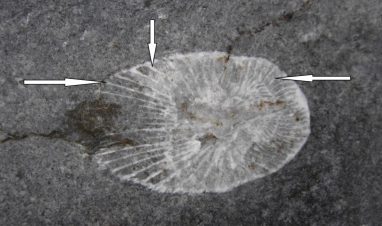
- Those thin white lines are the septa. The septa to the left appear to be longer; the more oblique the cross-section the more asymmetrical they will appear. In different orientations you won’t see the radial pattern; you might see a more complex pattern of wavy, parallel or network of lines.
- Horn shape. The overall shape of solitary corals looks like inverted horns.
The wider end is the uppermost end where the coral polyp lived.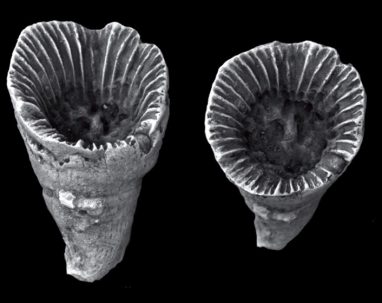
Solitary corals are usually quite small in the Burren, just a few cm, however they can be over 1m long. - White colour. Coral skeletons are composed of crystals of calcite which gives them a bright white colour.
Colonial Corals
- Individual parts of the colonial coral can look exactly like solitary corals so look for the same radial pattern.
- Clusters of corals. These can be either tightly or loosely packed together.
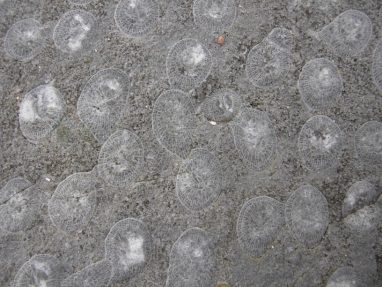
This is a section across the top of the colonial coral, picture these as branches, some are touching and others are not. Note the radial septa in each ‘branch’.
- Dome shape. The colony had a dome shape, which can be over 1m in diameter.
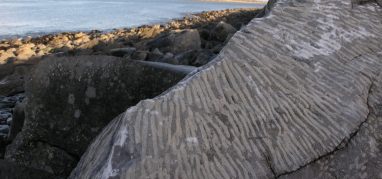
Crinoids
Crinoids are the most common fossil found in the Burren. They are extremely common in the limestone but very rare in the shale. Crinoids are rarely found intact in the Burren, usually we just find individual pieces but they can be so plentiful in places that they make up most of the rock.
What to look for
- Crinoid ossicles: These are the ‘building blocks’ of crinoids. They look like tiny disks, sometimes with a central hole. In life they are stacked on top of each other and held together by ligaments. They are made of individual crystals of calcite and freshly broken pieces will sparkle in sunlight.
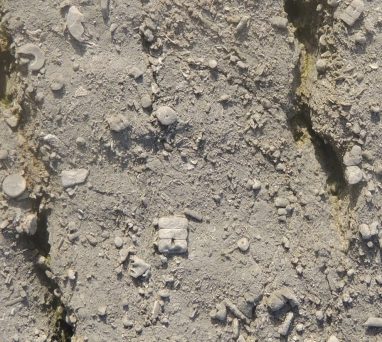
- Crinoid stem: Sometimes pieces of the stem (it is not a stem like a plant) remain partially attached together.
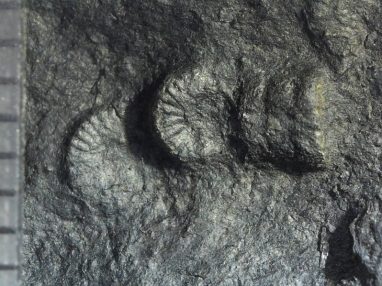
- Crinoid ‘arms’: These are the branched parts that collect food from the seawater, they can have a ‘feathery’ appearance because of increasingly smaller branches. These are made of ossicles too. Finding arms that are still connected together is very rare in the Burren, but here is an example from the shale: The smaller arms are about 1mm wide.
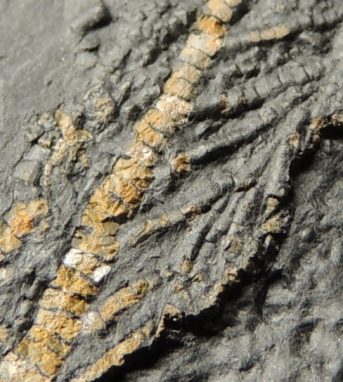
- The complete animal looked like a plant. They had a relatively long stem and the arms would have waved around in the sea collecting food. When the animal died, the ligaments usually decomposed quickly and all that was left were the individual ossicles. Each animal could produce hundreds of ossicles.
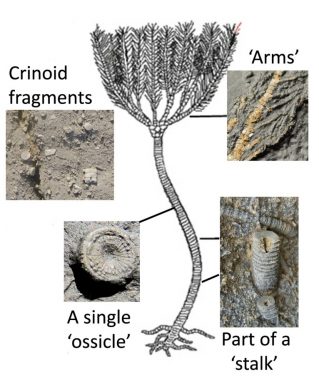
Brachiopods
Brachiopods in the Burren are relatively large (5-10cm) and are usually best seen in freshly broken surfaces, on exposed limestone pavement they are usually hard to spot as they are deeply weathered and often all that is left is a sub-circular depression or low mound. Brachiopods have two symmetrical opposing shells that are connected by a ‘hinge’ and held together by muscles when alive.
What to look for
- Gigantoproductus: This is a large brachiopod with a thickened lower shell. The shells are quite concave/convex. Sometimes they look like a white crescent shape in the rock if you are looking at a cross-section (on a vertical surface) through the brachiopod. Sometimes both shells are preserved still attached. In the image below showing 3 brachiopods the white parts are the calcite shell. Notice the thicker lower shell.
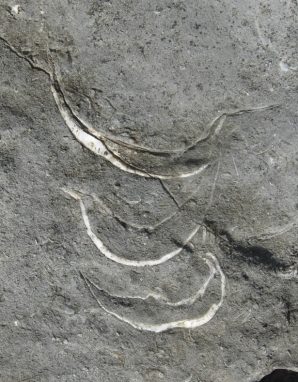
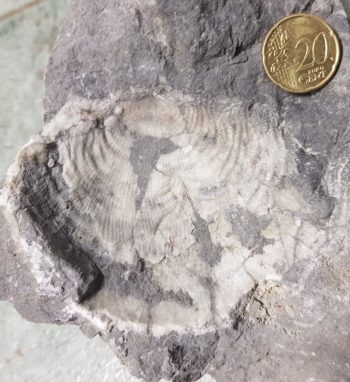
- Lingulid brachiopods: An entirely different kind of brachiopod is found in the shale, but is quite rare. These brachiopods are much smaller, usually less than 1cm. Their shells are mostly phosphate not calcite, so they are black and shiny.
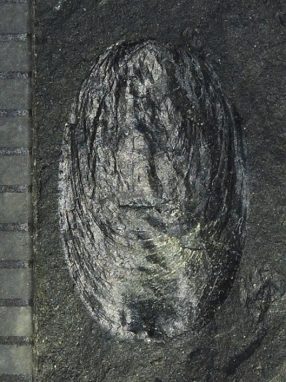
Plants
We find plenty of fossil plant material in the shale and sandstone, but apart from microscopic algae there are no fossil plants in the limestone. A lot of the plant material is fragmentary because it has been washed from land into the sea by ancient rivers; however, there are some nice exceptions.
What to look for
- Stigmaria. This is the name given to fossil roots. Sometimes we find them with fossil rootlets attached and we know they were preserved where they were growing, in a fossil soil. Stigmaria are thick and covered with circular pits, which is where rootlets were attached.
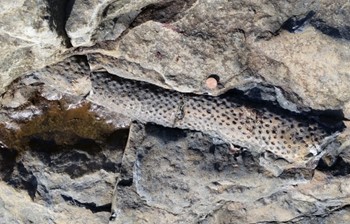
- Lepidodendron was a large tree-like plant that could be more than 40m tall. The trunk was covered in leaves that attached directly and left a pattern of rounded diamond-shaped leaf-scar marks when they fell off. However, sometimes this layer is not preserved and the inner layer looks a little different:
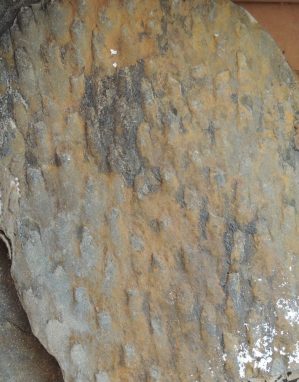
- Calamites: This is a fossil plant that is very similar to ‘mare’s tail’, which grows in abundance here. It can be identified by ridges that run the length of the stalk and by regularly spaced grooves that run across the stem. These grooves are where a ring of thin leaves were attached.
Usually they are preserved squashed flat but in sandstone they can be preserved in 3D. They vary in size from <1cm to over 1m long.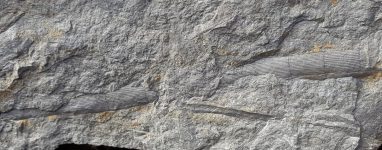
- Fossil ferns. Although they are 320 million years old, fossil ferns look just like modern ferns, so if you find one you will know what it is. Usually they are found as small fragments but sometimes exquisite detail is preserved. This piece is just over 1cm wide.
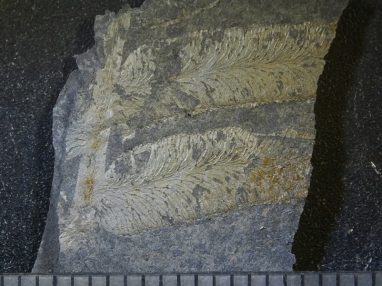
Cephalopods
Cephalopods are an amazing group of creatures that include squid, octopus, cuttlefish (not a fish) and the coiled-shelled Nautilus which are all alive in our oceans today. In the distant past cephalopods were a lot more abundant and we are fortunate to have a selection of these fossil cephalopods in the rocks of the Geopark. There are two basic shell types; coiled and straight.
What to look for
- Coiled cephalopods (Goniatites). These range in size from 1mm to 15cm in diameter, but the majority are around 1-2cm. The spiral shape is usually obvious and the only other creature they could be confused with is gastropods (snails) which also have a spiral shell. The coiled cephalopods are commonly known as ‘goniatites’ and if you look closely at the inside of one you should be able to see the internal chambers. Gastropods do not have these. Unfortunately, if you can only see the outside of the shell these chambers might not be visible. Details of the ornament on the outside of the shell are used to identify particular species of goniatites.
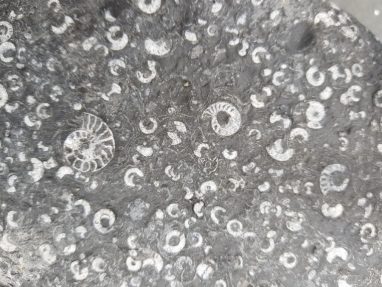
Notice the internal chambers in the coiled cephalopod shells.
- Straight-shelled cephalopods (Orthocones). These are usually thin, conical shells that may have a variety of ornament (such as ridges and grooves) on the outside of the shell. Inside they have similar chambers as the coiled cephalopods. Here, they range in size from 1cm to 15cm.
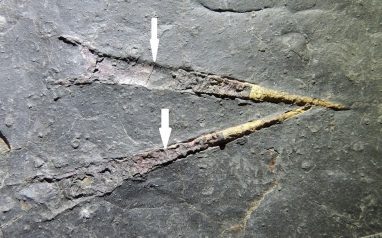
Bivalves
Bivalves are molluscs that have two shells such as oysters and scallops. They are easy to confuse with brachiopods which also have two shells, however bivalve shells are not symmetrical.
What to look for
- Dunbarella. This bivalve looks very similar to modern scallops and it is actually a distant relative. It is usually about 4cm wide, thin and flat with characteristic prominent radiating ridges and grooves.
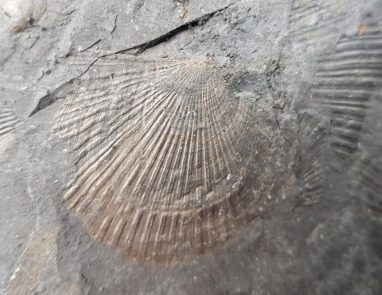
Trace Fossils
When is a fossil not a fossil? When it is a trace fossil! Trace fossils are the marks (footprints, tracks, trails, burrows) made by animals when they were alive. Usually the fossil animal that made the trace is not found with it, so it can very difficult to say what made them.
What to look for
- Moher flags: The Moher flags (flags=flagstones) are thin-bedded sandstones that are often covered in horizontal, long sinuous marks about 1-2cm wide. They often have a central ridge or furrow. Sometimes you will see thin, internal curved bands; these are the layers of sediment that the creature pushed backwards behind itself in the burrow. This is what filled the burrow and stopped it from collapsing afterwards. The creature that burrowed through the sand is thought to have been a mollusc of some kind.
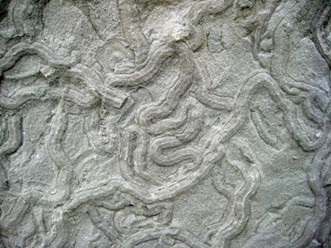
- Psilonichnus: Some creatures made vertical burrows on the seafloor. These vertical burrows were infilled with coarser sediment which is how they got preserved. We think these burrows were made by a shrimp but there are other possibilities.
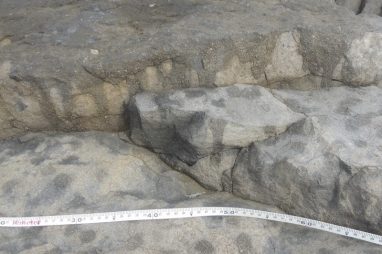
For information about any fossils in the Burren and Cliffs of Moher UNESCO Global Geopark contact Dr. Eamon Doyle at info@burrengeopark.ie.